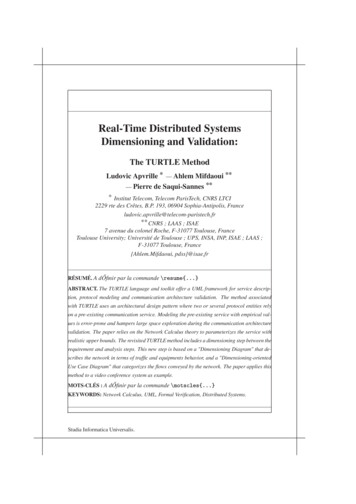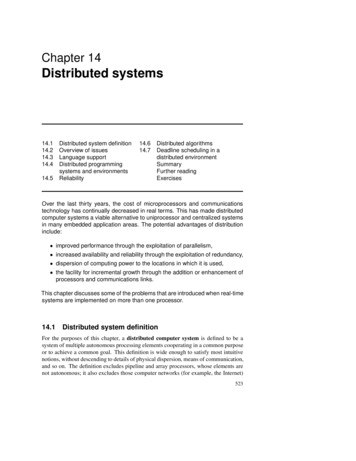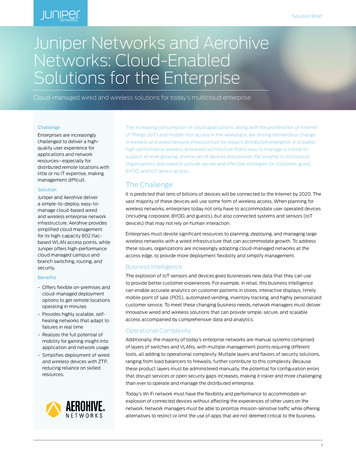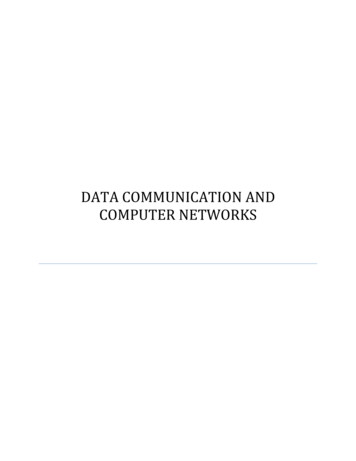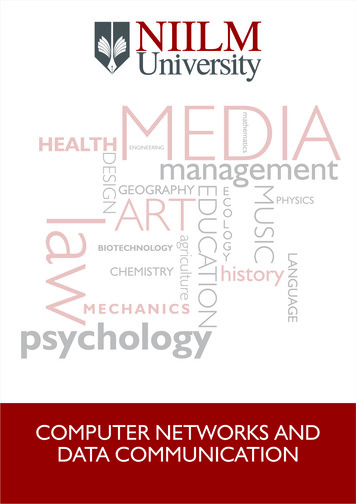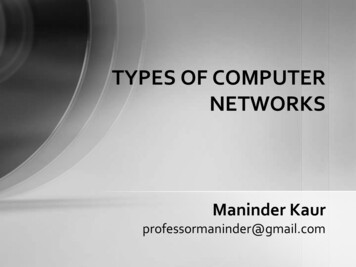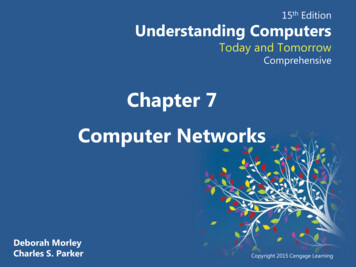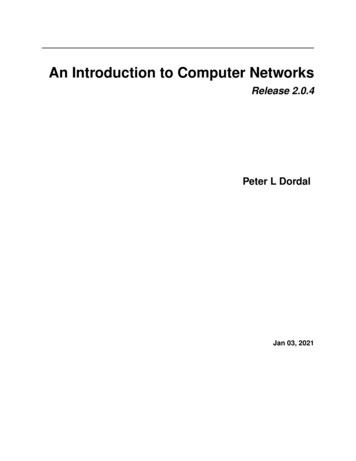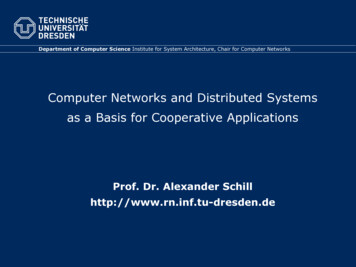
Transcription
Department of Computer Science Institute for System Architecture, Chair for Computer NetworksComputer Networks and Distributed Systemsas a Basis for Cooperative ApplicationsProf. Dr. Alexander Schillhttp://www.rn.inf.tu-dresden.de
Outline§ Distributed Systems on top of Computer Networks§ Typical Architectures§ Research Topics:- Network Emulation as a Basis- Cloud EnvironmentsProf. Dr. Alexander SchillFolie 2
What are Distributed Systems?§ “A Distributed System comprises several singlecomponents on different computers, which normallydo not operate using shared memory and as aconsequence communicate via the exchange ofmessages. The various components involvedcooperate to achieve a common objective such as theperforming of a business process.”§ Main Characteristics: Multiple individual componentsSpatially separated componentsComponents posses own memoryAccess to common resources (e.g. databases)Communication via messagesCooperation towards a common objectiveProf. Dr. Alexander SchillFolie 3
Computer Network: TopologyLANWANLANLAN(for instancehigh performancenetwork)LAV.A.N.Value added networkNDistributedOS§ § Networked workstations, also organizationally integratedSuper-proportionally increasing communication performanceProf. Dr. Alexander SchillDistributed DBFolie 4
Example: Distributed SystemLANWANLANDistributedOS§ LAN(for instancehigh performancenetwork)ProcessLAValue added networkNLogicalcommunication pathApplication components (domain-specific) on top ofinfrastructureProf. Dr. Alexander SchillV.A.N.Distributed DBFolie 5
Example System: E-CommerceApplication ServerClientStore managementStoretablesApplication ServerWebServerClientPurchase OrderPreprocessingWeb ServiceApplication ServerAdministration ofcustomer dataClientOnline shopCustomerdataWeb ServiceApplicationServerDatabaseSupplierProf. Dr. Alexander SchillFolie 6
Distributed System Example: InfrastructureClient(E.g.Point of Sale)ServerServer(E.g.Preprocessing)(E.g. Customerhistorydatabase)Client(E.g.Fieldworker)§ Requirements:Client(E.g.HomeAccess)Prof. Dr. Alexander Schill Decentralized system structureScalabilitySecurity conceptsTransaction processingHeterogeneity of systemsFolie 7
Architectures: Two/Three TierClient(e.g. Point of Sale)Client(e.g.Fieldworker)Client(e.g. HomeAccess)Server(E.g.preprocessing)Application Logic(Processing Tier)Prof. Dr. Alexander Schill(E.g. Customerhistory database)Data management(Persistence Tier)§ 2-tier: two-level structure(user-interface - Host);simple, but less flexible§ 3-tier: three-level structure; preferablefor complex applicationsUser interface, if necessarypre-processing (thin client vs.fat client)(Presentation Tier)ServerFolie 8
Architectures: CloudClient(E.g. Point of Sale)ClientPrivate / Public CloudIntranet /Internet(E.g. Fieldworker)Client(E.g. HomeAccess)Prof. Dr. Alexander SchillFolie 11
Architectures: Cloud§ Cloud - Availability and use of computing power in a wayanalogous to the provision of water and electricity in modernutility grids (transparently operating as a “cloud”)§ Single organisations may not have sufficient resources fordata and computationally intensive problems§ Aggregation of computing resources from multipleorganisations§ Individual organisations can access resources on demand tocater for fluctuating need§ Saving in processing time and hardware costs outweighs therise in coordination and synchronisation complexity§ E.g. Projects: Earth System Grid, Human Genome Research,Commercial cloud providers (Amazon, T-Systems, IBM, )Prof. Dr. Alexander SchillFolie 12
Architectures: er)ClientPeerPeerClientClientPeerClient§ § § § PeerPeerDirect communication between peersOption of no centralised architecturePeers both service providers and usersMechanism for finding service providing peers necessaryProf. Dr. Alexander SchillFolie 13
References§ § § Schill, A., Springer, T.: Verteilte Systeme - Grundlagen undBasistechnologien. Springer, Berlin, 2012Tanenbaum, A.S., van Stehen, M.: Distributed Systems:Principles and Paradigms. Prentice Hall International, 2008Steinmetz, R. & Wehrle, K.: Peer-to-Peer Systems andApplications. Springer, Berlin, 2005Prof. Dr. Alexander SchillFolie 15
Network Emulation: Motivation§ An Example of a distributed system: the video conferencing andmeeting software GoToMeeting by Citrix, Online Services DivisionProf. Dr. Alexander SchillFolie 16Source: Citrix Online,
Motivation§ Problems when testing distributed systems Systems can have huge dimensionso Peer2Peer systemso Conference and meeting systems for up to 1000 participantso à scalability and load tests are necessary Heterogeneity of the endpointso PCso Notebooks, smartphones, tablets à mobilityo Different network access technologies: DSL, Cable, WiFi,WiMax, § Solution: Scalability tests including different network characteristicsand behaviorProf. Dr. Alexander SchillFolie 17 à NESSEE: Network Endpoint Server Scenario Emulation
Example scenariosProf. Dr. Alexander Schill13.03.2012Folie 18 von Folie 18
NESSEE research questions§ What are the important network parameters, characteristicsand effects for scalability tests of distributed systems? Bandwidth, delay, jitter, loss, duplication, corruption,reordering, background traffic, asymmetric routes,bandwidth sharing, § How to determine real world parameter values for the networkemulation?§ What is necessary to emulate very large scenarios? Can existingsolutions already cover this? 1000 network nodes§ How to dynamically reconfigure the network emulation duringruntime of the tests? Emulation of disconnections and varying parametersProf. Dr. Alexander SchillFolie 19
Reproducing network behavior§ Simulation Simulation of the network using software thatusually runs on only one machine Huge scenarios cannot be simulated on one machine§ Emulation Reproduction of a computer network with specificcharacteristics on a real physical computer network Modification of real network traffic Using hardware – high performance and accuracy Using software – dynamic configuration, flexible Using emulation environmentso Test networks with many nodes (Cooperation of universitiesand research institutes)o Testing of distributed systems by deploying it on the nodes Emulation allows real endpoint software to join a testProf. Dr. Alexander SchillFolie 20
Existing solutions§ Simulators ns-2, ns-3 (also emulation mode), OMNET , NetSim,NCTUns, QualNet, OPNET, SSFNet, yans, GTNetS,GloMoSim, OSA, JiST/SWANS, cnet, simscript, Traffic,Shunra VE, Extend, INES, J-Sim, HEGONS, Narses, 3LS,NeuroGrid, P2PSim, PeerSim, ONE§ Hardware emulators Apposite LinkTropy 7500 (Energy Lab)§ Software emulators NetEm, NISTNet, DummyNet, KauNet, EMPOWER,NetPath, WanEm, „EstiNet 7.0 Network Simulator andEmulator“ / NCTU ns§ Emulation environments PlanetLab, OneLab, VINI, Emulab, ORBIT, WhyNetProf. Dr. Alexander SchillFolie 21
NESSEE architecture§ § § § NESSEE Editor: Authoring tool to create test cases written in the genericTest Description Language (TDL)NESSEE Server: coordination of the testDegrader: network emulation based on the TDL specificationTest systems for client and server components of the Software Under TestProf. Dr. Alexander SchillFolie 22
WAN V.A.N. Value added network Distributed DB Computer Network: Topology . Prof. Dr. Alexander Schill Folie 5 Distributed OS LAN (for instance high performance network) LAN L A N L A N WAN V.A.N. Value added
